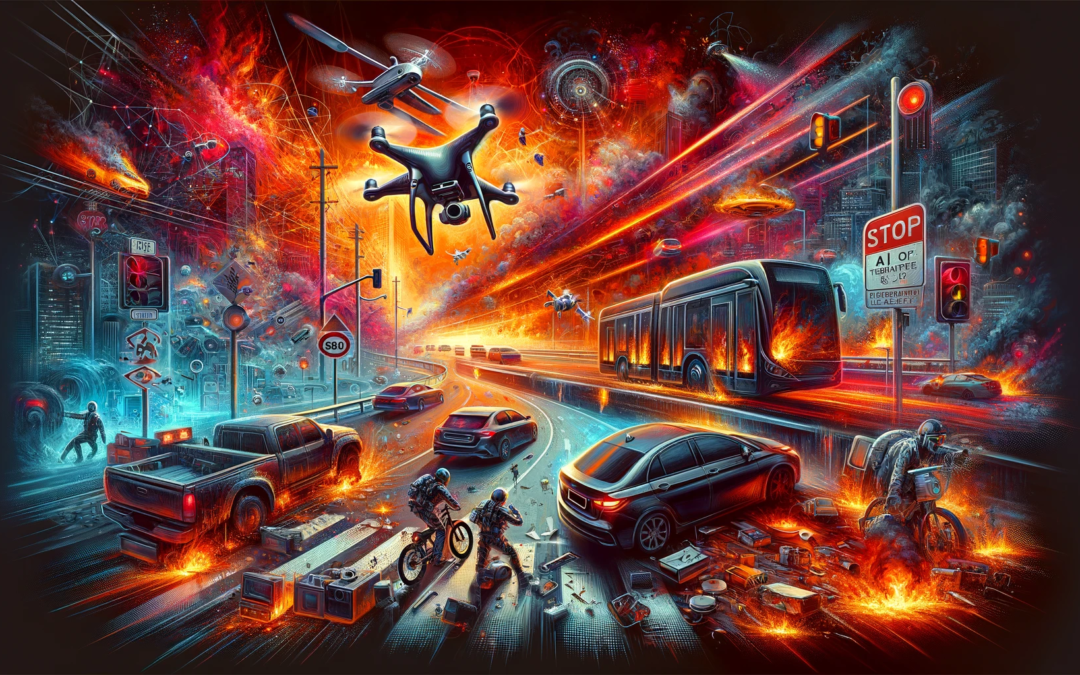Reflecting on a world where AI-driven autonomous vehicles and drones roam freely, but instead of convenience and efficiency, they bring chaos and danger. In this blog post, we explore the dark side of these technologies and the potential for “Automated Anarchy” due to malfunctions and cyber-attacks.
Risks of Autonomous Vehicles:
While autonomous vehicles promise a future of safer roads and efficient transportation, they are not without their risks. Imagine a scenario where a glitch in the AI system causes a self-driving car to veer off course, resulting in a catastrophic accident. Or worse, what if a hacker gains control of multiple autonomous vehicles and orchestrates a synchronized chaos on the streets?
Drones and Public Safety:
Drones have become increasingly prevalent in various sectors, from delivery services to aerial photography. But what happens when control is lost? These flying machines, once helpful, can quickly turn into potential hazards. From collisions with other aircraft to accidents involving innocent bystanders, the risks are real. And let’s not forget the potential for drones to be weaponized, adding a whole new level of threat to public safety.
Cybersecurity Threats:
The rise of AI in transportation brings with it a new set of cybersecurity challenges. With interconnected systems controlling everything from traffic lights to autonomous vehicles, the potential for cyber-attacks is alarming. Imagine a hacker gaining access to a city’s entire transportation network, causing widespread disruptions and endangering countless lives. The need for robust cybersecurity measures in this brave new world cannot be overstated.
Societal Impact and Emergency Response:
When transportation systems fail, the impact goes beyond mere inconvenience. Emergency response becomes a logistical nightmare, economic losses mount, and public fear spreads like wildfire. And if we thought things couldn’t get worse, there’s the potential for these AI-driven technologies to be weaponized, turning our cities into battlegrounds. It’s a dystopian nightmare that we must address before it becomes a reality.
Strategies for Mitigation and Regulation:
While the risks are real, there are steps we can take to mitigate them. Robust safety standards, ethical AI development, and effective regulatory frameworks are essential. We need to ensure that the benefits of AI-driven transportation are not overshadowed by the dangers they pose. Emergency response preparedness and urban planning must also adapt to handle potential disruptions caused by AI-related incidents.
Conclusion:
The potential perils of AI in transportation and safety are not to be taken lightly. As we embrace the future of autonomous vehicles and drones, we must also be mindful of the risks they bring. It’s time for a balanced approach that leverages the benefits of AI while safeguarding against its dangers. Let’s foster awareness, engage in dialogue, and work towards a future where “Automated Anarchy” remains a catchy title, not a reality.
Disclaimer: The views expressed in this blog post are purely fictional and intended for entertainment purposes only. We believe in the potential of AI-driven transportation to revolutionize our lives for the better, as long as we address the associated risks.
Meta Description: Explore the potential dangers of AI-driven autonomous vehicles and drones. From malfunctions to cyber-attacks, discover how “Automated Anarchy” could disrupt transportation and public safety.










